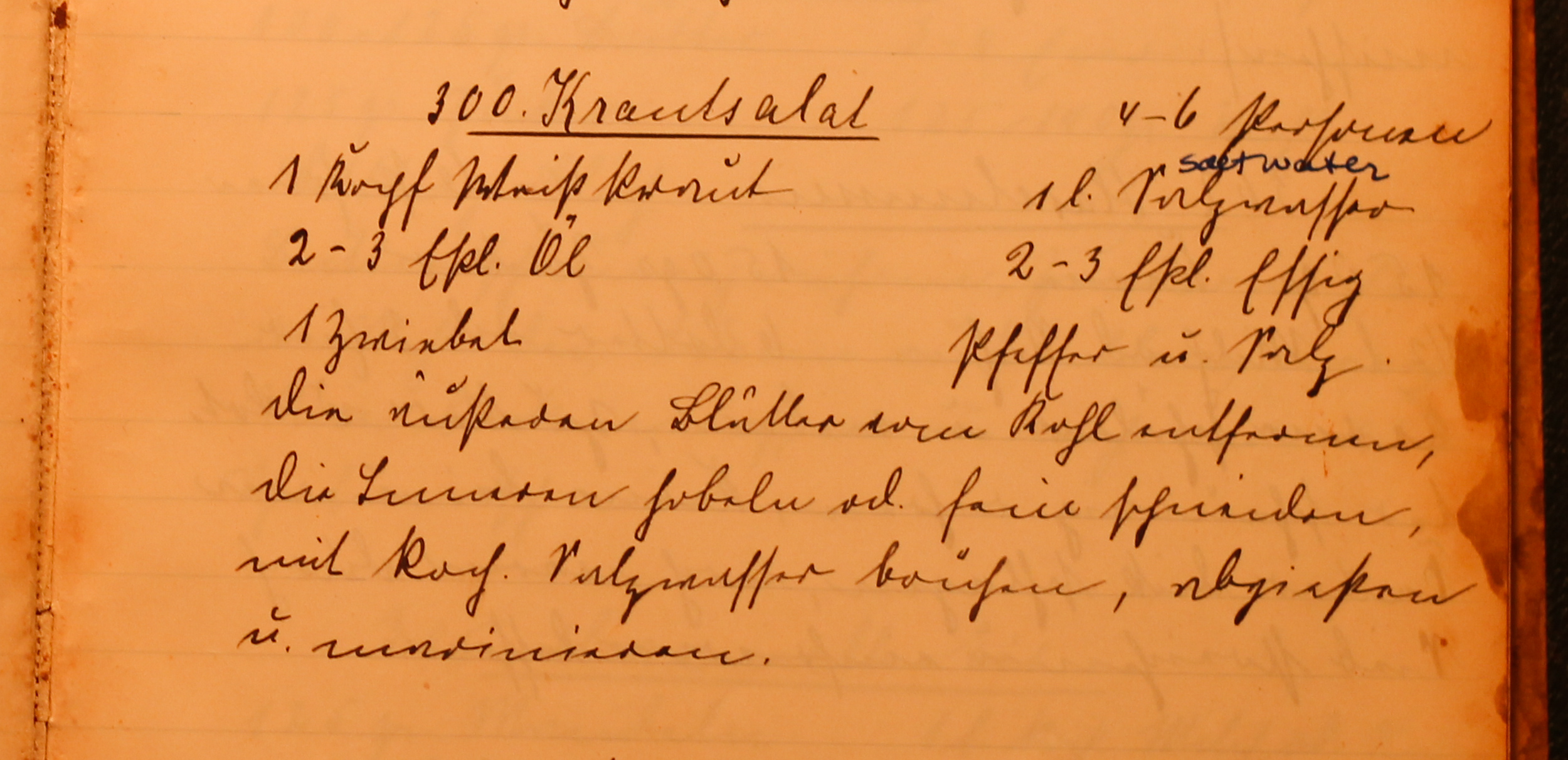Krautsalat (Cabbage Slaw) • Sonya Gropman
Bretty Rawson
Note from curator Rozanne Gold: We are delighted to have this beloved recipe for Emma Marx’s cabbage slaw, translated and submitted by her great granddaughter, Sonya Gropman. It is but one of more than 100 recipes to be published next year in “The German-Jewish Cookbook: Recipes and History of a Cuisine,” co-written by Sonya and her mother, Gabrielle Rossmer Gropman (University Press of New England). The gorgeous narrative, spanning the kitchens of four generations, is part of the HBI Series on Jewish Women (the Hadassah-Brandeis Institute.) I especially love the photo of Emma’s old-fashioned wooden mandolin that was used to shred cabbage, cucumbers, and onions. And you will no doubt enjoy preparing the dish, faithfully, just as much as I did. We look forward to the book’s publication in September 2017.
Krautsalat (Cabbage Slaw) by Sonya Gropman
My mother grew up in a household where three adults cooked on a regular basis — her mother, grandmother, and father (her grandfather, who also lived with them, didn’t cook). The family had fled Nazi Germany in 1939, when my mother was a one-year old baby and settled in Washington Heights, a neighborhood in upper Manhattan that was home to approximately 20,000 German-Jews. German was frequently heard spoken by people on the street and there were many businesses that catered to the community, including food shops. Thus, it was easy for people to continue eating the same foods they had eaten in Germany.
Many German-Jewish families arrived in the U.S. with a household worth of personal belongings. Unlike most other refugees — who might arrive with just a single bag or suitcase after fleeing their homeland — German-Jews often brought the entire contents of their homes, which had been packed into enormous wooden crates called a lift van. This box of possessions included all the usual items that fill a household, both big and small — from furniture, to clothing, to cookware, and everything in between. That this happened was due to a perverse policy of the Nazis. It was a way for them to collect taxes on everything Jews packed, and it also demonstrated their imminent departure from Germany.
Much of the cookware and dishes brought by our family, which dates from the early 1900s to the 1930s, survives and is still in use by both me in my kitchen, and by my mother in hers. There are family objects that I use on a daily basis, including knives, a colander, and sauce pans. It is a testament to how well-made these objects are and still functional many decades later.
My mother has a wooden mandolin that belonged to her grandmother, Emma. By today’s standards, it seems very basic as it lacks folding legs to prop up the blade (instead it must be held at an angle with one’s hand), and is has a fixed blade, so that the thickness of the slices is not adjustable. To our knowledge, the blade has never been sharpened, yet it remains quite sharp. My mother uses it regularly to slice vegetables such as cucumbers and onions. She also uses it to shred green cabbage in order to make Green Cabbage Slaw, or Krautsalat, a dish that her grandmother frequently made for holiday meals during her childhood. It accompanied any number of meat meals, such as roast duck or goose, tongue, or veal roast. It was a favorite dish of my mother’s and she was thrilled to find the recipe in a cookbook her grandmother had handwritten when she attended cooking school in Germany before she was married in the early 1900s. My mother set about making the recipe, but the finished dish didn’t quite match her memory of how it tasted during her childhood. She tinkered with the recipe, comparing the list of ingredients and the written instructions with her memory of it. She realized that even though the written recipe included onion, Emma had not used it in her version. Eventually she came up with a recipe for the dish that tasted exactly the way she remembered it.
When I first saw the recipe, I was struck by my great-grandmother’s beautiful, fluid script, written in a form of Old German that is very difficult to read. I then noticed a translation for “salt water” written in blue ink, jotted down by a frustrated translator (my mom), who was relieved to figure out the word. At first I was sorry to see the page marred by contemporary writing, but I later realized that it adds another layer to the history of the recipe, keeping it alive and in the present.
This recipe is remarkable in that a short list of ingredients is transformed, seemingly through a bit of alchemy, into something so addictively delicious. Falling somewhere between coleslaw and sauerkraut, it uses boiling salt water to break down the shredded cabbage into a slightly wilted and softened state. A light vinaigrette dresses the cabbage, while brightening its taste with the acidity of vinegar.
Cabbage Slaw (Krautsalat)
8-10 servings
This dish is best if the cabbage is finely shredded. If you do not have a mandolin, use the long blade on a box grater, the slicer attachment on a food processor, or a sharp knife to slice the cabbage as thinly as possible. This recipe is the original version, but feel free to try the variation we discovered below which uses a few non-traditional additions.
1 medium sized head of green cabbage
1 quart of water
2 tablespoons of salt + extra if needed
4 tablespoons white wine vinegar
ground white, or black pepper, to taste
2 tablespoons neutral oil, such as canola or safflower
Prepare the cabbage:
Shred the cabbage into a large glass, ceramic, or stainless steel bowl. Boil the water with the salt. Pour the boiling saltwater over the shredded cabbage. Let it sit until the water is cool, between 30 minutes to 1 hour. Pour the cabbage into a colander set in the sink to drain the water. Press down with a plate that is slightly smaller than the colander to press out as much water as possible. Put the shredded cabbage in a serving bowl.
Make the Vinaigrette:
Pour the vinegar and pepper into a small bowl. Slowly add the oil, while whisking, until blended. Pour the vinaigrette over the cabbage, tossing to coat evenly. Taste for salt, adding more if needed.
Serve:
The slaw will be ready to eat immediately, though the taste and texture will mellow and improve if allowed to stand for an hour or more. Serve chilled, or at room temperature.
Variation: Prepare cabbage as in step #1 above, adding some or all of the following ingredients to the drained cabbage in the bowl:
2 carrots, shredded on large holes of a box grater
1 small shallot, minced
1 bunch arugula, finely chopped
1-2 tablespoons minced fresh herbs, such as marjoram, parsley, or thyme
Continue with steps #2 and #3
© 2016 Gabrielle Rossmer Gropman & Sonya Gropman The German-Jewish Cookbook: Recipes and History of a Cuisine
*HBI is the Hadassah-Brandeis Institute, an academic center at Brandeis University which promotes scholarly research, artistic projects and public engagement.





